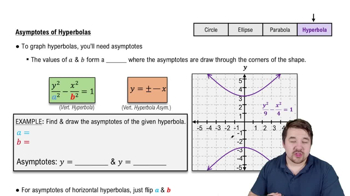Determine and for the following functions. Then give the horizontal asymptotes of (if any).
Table of contents
- 0. Functions7h 52m
- Introduction to Functions16m
- Piecewise Functions10m
- Properties of Functions9m
- Common Functions1h 8m
- Transformations5m
- Combining Functions27m
- Exponent rules32m
- Exponential Functions28m
- Logarithmic Functions24m
- Properties of Logarithms34m
- Exponential & Logarithmic Equations35m
- Introduction to Trigonometric Functions38m
- Graphs of Trigonometric Functions44m
- Trigonometric Identities47m
- Inverse Trigonometric Functions48m
- 1. Limits and Continuity2h 2m
- 2. Intro to Derivatives1h 33m
- 3. Techniques of Differentiation3h 18m
- 4. Applications of Derivatives2h 38m
- 5. Graphical Applications of Derivatives6h 2m
- 6. Derivatives of Inverse, Exponential, & Logarithmic Functions2h 37m
- 7. Antiderivatives & Indefinite Integrals1h 26m
- 8. Definite Integrals4h 44m
- 9. Graphical Applications of Integrals2h 27m
- 10. Physics Applications of Integrals 3h 16m
- 11. Integrals of Inverse, Exponential, & Logarithmic Functions2h 34m
- 12. Techniques of Integration7h 39m
- 13. Intro to Differential Equations2h 55m
- 14. Sequences & Series5h 36m
- 15. Power Series2h 19m
- 16. Parametric Equations & Polar Coordinates7h 58m
1. Limits and Continuity
Introduction to Limits
Problem 2.5.45
Textbook Question
Determine limx→∞f(x) and limx→−∞f(x) for the following functions. Then give the horizontal asymptotes of f (if any).
 Verified step by step guidance
Verified step by step guidance1
Identify the dominant terms in the numerator and the denominator as x approaches infinity and negative infinity. For f(x) = \frac{1}{2x^4 - \sqrt{4x^8 - 9x^4}}, the dominant term in the denominator is \sqrt{4x^8} = 2x^4 when x is large.
Simplify the expression by factoring out the dominant term from the square root in the denominator: \sqrt{4x^8 - 9x^4} = x^4\sqrt{4 - \frac{9}{x^4}}.
Rewrite the function f(x) in terms of the dominant term: f(x) = \frac{1}{2x^4 - x^4\sqrt{4 - \frac{9}{x^4}}} = \frac{1}{x^4(2 - \sqrt{4 - \frac{9}{x^4}})}.
Evaluate the limit as x approaches infinity: lim_{x \to \infty} f(x) = lim_{x \to \infty} \frac{1}{x^4(2 - \sqrt{4 - \frac{9}{x^4}})}. As x becomes very large, \frac{9}{x^4} approaches 0, so \sqrt{4 - \frac{9}{x^4}} approaches 2, making the denominator approach x^4(2 - 2) = 0. Therefore, the limit is undefined, indicating no horizontal asymptote at infinity.
Evaluate the limit as x approaches negative infinity: lim_{x \to -\infty} f(x) = lim_{x \to -\infty} \frac{1}{x^4(2 - \sqrt{4 - \frac{9}{x^4}})}. The analysis is similar to the positive infinity case, and the limit is also undefined, indicating no horizontal asymptote at negative infinity.
 Verified video answer for a similar problem:
Verified video answer for a similar problem:This video solution was recommended by our tutors as helpful for the problem above
Video duration:
6mPlay a video:
Was this helpful?
Key Concepts
Here are the essential concepts you must grasp in order to answer the question correctly.
Limits at Infinity
Limits at infinity describe the behavior of a function as the input approaches positive or negative infinity. This concept is crucial for understanding how functions behave in extreme cases, allowing us to determine horizontal asymptotes. For example, if the limit of f(x) as x approaches infinity is a finite number, it indicates that the function approaches a horizontal line at that value.
Recommended video:

Cases Where Limits Do Not Exist
Horizontal Asymptotes
Horizontal asymptotes are lines that a graph approaches as x approaches infinity or negative infinity. They provide insight into the end behavior of a function. If a function has a horizontal asymptote at y = L, it means that as x becomes very large or very small, the function values get closer to L, indicating stability in the function's output at extreme values.
Recommended video:

Asymptotes of Hyperbolas
Rational Functions
Rational functions are ratios of polynomials, expressed in the form f(x) = P(x)/Q(x), where P and Q are polynomials. Understanding the degrees of the polynomials in the numerator and denominator is essential for analyzing limits at infinity and determining horizontal asymptotes. The behavior of these functions can vary significantly based on the relative degrees of P and Q.
Recommended video:

Intro to Rational Functions

 6:47m
6:47mWatch next
Master Finding Limits Numerically and Graphically with a bite sized video explanation from Patrick
Start learningRelated Videos
Related Practice
Textbook Question
243
views
